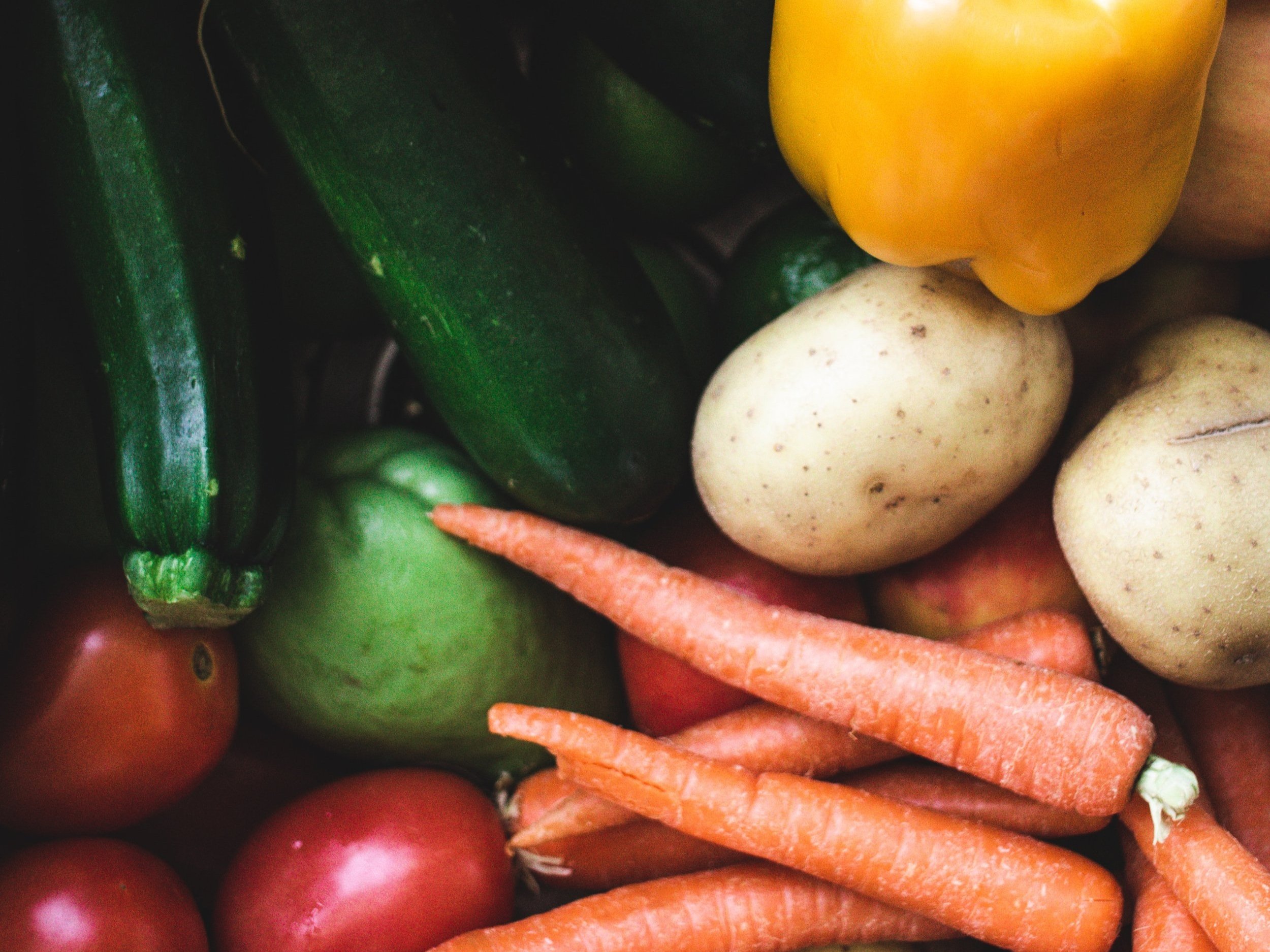How to Create a Sustainable Beauty Routine
In a world where beauty trends change rapidly, it’s easy to accumulate products that harm both the environment and our skin. But beauty doesn’t have to come at the cost of sustainability.
By making mindful choices, we can build a beauty routine that’s both eco-friendly and effective. Not sure how sustainable your beauty products are? Try our free quiz!
Here’s how to embrace a sustainable beauty routine without compromising on quality or results.
Photo by Kalos Skincare on Unsplash
1. Choose Sustainable and Ethical Brands
The easiest way to make your beauty routine greener is by supporting brands that prioritise sustainability. Look for companies that:
• Use natural, organic, or upcycled ingredients (COSMOS*)
• Offer refillable or minimal packaging.
• Commit to cruelty-free and vegan formulas (Ve or Leaping Bunny)
• Support ethical sourcing and fair-trade practices.
• Are B Corps
*COMOS = Cosmetic Organic and Natural Standard
Look out for small local sustainable brands at Makers’ Markets and indie makers’ shops.
Photo by Viva Luna Studios on Unsplash
These well-established companies are all UK-based
• B- Corp, The Body Shop is well-known for its affordable eco-friendly beauty products. It uses 100% recycled plastic in many of its products, is committed to Fair Trade and offers a recycling program in stores.
• Lush is famous for its fresh, handmade cosmetics. Using minimal packaging, they encourage customers to return containers for recycling. Their products are often vegan and cruelty-free.
• Neal's Yard Remedies emphasizes organic and natural ingredients. They use recyclable packaging and have a strong commitment to sustainability and ethical sourcing.
• Rituals focuses on creating luxurious products inspired by ancient traditions. They are committed to sustainable practices and use recyclable materials in their packaging.
• Green People specialises in organic skincare and beauty products prioritising natural ingredients and eco-friendly packaging. Certified cruelty-free, they offer many vegan products.
• Wild makes refillable deodorants that use sustainable materials. The brand emphasizes reducing plastic waste and offers a range of natural, vegan options.
• Flora & Curl specialises in natural hair care products for curly hair. They use organic ingredients and eco-friendly packaging, focusing on sustainability and ethical sourcing.
• Evolve Beauty offers a range of natural and organic skincare products made in small batches in the UK. They use sustainable packaging and focus on eco-friendly practices throughout their production process.
Photo by Eir Health on Unsplash
2. Simplify Your Beauty Routine
Less is more when it comes to sustainability. Instead of multiple using products, opt for multi-purpose beauty essentials like:
• A tinted moisturiser with SPF—hydrates, protects, and evens out skin tone.
• Multipurpose balms—great for lips, cheeks, and cuticles.
• Cleansing oils—remove makeup and cleanse skin in one step.
Photo by mahdi chaghari on Unsplash
3. Switch to Plastic-Free & Refillable Packaging
The beauty industry generates 120 billion units of plastic waste annually, most of which isn’t recyclable. Opt for:
• Glass, metal, or bamboo packaging instead of plastic.
• Refillable beauty products, such as shampoos, foundations, and perfumes.
• Solid beauty bars (shampoo, conditioner, and cleanser) to cut down on single-use bottles.
Many sustainable brands including Lush, Neal’s Yard, Beauty Kitchen and Evolve Organic Beauty offer postal refill services, making it even easier to reduce packaging waste.
Photo by Towfiqu barbhuiya on Unsplash
4. DIY Your Beauty Products
Making your own beauty products reduces waste and ensures clean, natural ingredients. Simple DIY ideas include:
• Face mask: Mix oats, honey, and yogurt for a soothing treatment.
• Body scrub: Combine coffee grounds, coconut oil, and sugar for an exfoliating scrub.
• Lip balm: Melt beeswax, shea butter, and coconut oil for a nourishing balm.
5. Beauty Tools Swaps
Swap disposable beauty items for reusable alternatives, such as:
• Bamboo makeup brushes and toothbrushes instead of plastic ones.
• Reusable cotton rounds or cloths instead of single-use wipes.
• Menstrual cups or reusable pads/ pants instead of disposable tampons.
• Safety razors instead of plastic razors.
Photo by Nataliya Melnychuk on Unsplash
6.Recycle and Repurpose Your Products
When you finish a product, check if the packaging is recyclable. Some brands, like Lush and MAC, offer take-back programs where you can return empty containers in exchange for discounts or free products.
To make it even easier to recycle, the British Beauty Council launched The Great British Beauty Clean-up in March this year. Visit their site to locate your nearest Beauty Takeback Recycling Point
https://britishbeautycouncil.com/recycling-points/
You can also repurpose jars and bottles—use them for DIY beauty products, storage, or even as plant holders!
Go to the end to download our handy free recycling chart.
Photo by Marine Sintes on Unsplash
7. Add a recycling bin to your Bathroom
Research shows that bathroom and beauty products often get left out of recycling routines and end up in landfill. Putting a small recycling bin makes it easier to send paper and plastic products to the right place.
Look out for small “double” bins with two compartments if you are short of space.
Photo by Alexander Mass on Unsplash
8. Support Sustainable Beauty Trends
The beauty industry is evolving, and sustainability is at the forefront. Some exciting trends include:
• Waterless beauty—concentrated formulas with little to no water usage.
• Upcycled ingredients—brands using byproducts from food industries (like coffee or fruit peels) in skincare.
• Slow beauty—prioritising quality, multi-use products over excessive consumption.
By supporting these innovations, you help push the beauty industry toward a greener future.
Photo by Nataliya Melnychuk on Unsplash
9.One Swap at a Time
Sustainable beauty isn’t about perfection—it’s about progress. By making small, conscious changes, you can reduce waste, support ethical brands, and create a routine that’s kinder to both your skin and the planet.
Start where you can and remember: every sustainable swap makes a difference!
#SustainableBeauty #EcoFriendlySkincare #GreenBeauty #ZeroWasteBeauty #MindfulLiving
Sustainable Beauty Quiz
Photo by Fleur Kaan on Unsplash
Free Beauty Product Recycling Chart
How to Eat Sustainably and Locally
Photo by Nadine Primeau on Unsplash
January is a great time to reflect on our choices and consider how to bring our lifestyles more in line with our values. Our food choices have a profound impact not only on our health but also on the planet. Eating sustainably and locally can help reduce your carbon footprint, support local farmers, and promote biodiversity.
Here’s a comprehensive guide to making informed and mindful food decisions.
Photo by Odiseo Castrejon on Unsplash
Why Eat Sustainably and Locally?
Environmental Impact: The global food system accounts for a significant portion of greenhouse gas emissions. By choosing local and seasonal foods, you reduce the energy needed for transportation, storage, and processing.
Supporting Local Economies: Buying directly from British farmers boosts regional economies and helps preserve farmland. Supporting UK agriculture also reduces reliance on imports.
Fresher, Healthier Food: Locally grown produce is often fresher and more nutrient-rich since it doesn’t spend weeks in transit.
Preserving Biodiversity: Small-scale British farms are more likely to grow diverse crops, which helps maintain soil health and ecosystem balance.
Photo by Brooke Lark on Unsplash
Practical Tips for Eating Sustainably and Locally
1. Reduce meat and dairy. January is a great time to cut down on the animal products in your diet. Look out for Veganuary offers on plant-based foods and take the opportunity to try something new.
Photo by roam in color on Unsplash
2. Shop at Farmers' Markets and Farm Shops Farmers' markets and shops across the UK offer fresh, seasonal, and locally grown produce. Check local online message boards for information about Farmer’s Markets. Search Farminguk.com for a list of nearby farm shops.
Photo by Shelley Pauls on Unsplash
3. Join a Veg Box Scheme Subscribing to a local veg box scheme, such as Oddbox, Riverford or Abel & Cole, connects you directly with British farms. You’ll receive regular boxes of fresh, seasonal produce delivered to your doorstep.
Photo by Davor Nisevic on Unsplash
4. Eat Seasonally Seasonal eating in the UK means enjoying strawberries in the summer, root vegetables in the winter, and apples in the autumn. It’s fresher, tastier, and reduces the environmental impact of importing out-of-season items.
Photo by Anastasia Zhenina on Unsplash
5. Grow Your Own Food Even a small garden or allotment can provide fresh herbs, vegetables, or fruits. Local councils often have allotment schemes for those without gardens.
Photo by Markus Spiske on Unsplash
6. Prioritise Plant-Based Meals Shifting towards a plant-based diet reduces the environmental toll of animal agriculture. Incorporate more legumes, grains, and vegetables into your meals to lower your carbon footprint. Look for British-grown pulses like fava beans and lentils.
Photo by 360floralflaves on Unsplash
7. Choose Sustainable Proteins Reduce meat in take swap to sustainable plant based proteins. If you eat meat, opt for locally raised, pasture-fed options from UK farms. For seafood, consult the Marine Conservation Society’s Good Fish Guide to ensure sustainable choices.
Photo by Veronica White on Unsplash
8. Reduce Food Waste Plan meals carefully and use leftovers creatively to minimise waste. Composting food scraps is another great way to give back to the soil, and many councils offer compost bin schemes.
Photo by Gabriel Jimenez on Unsplash
9. Avoid Over-Packaged Foods Shop at zero-waste stores or bring your own containers to supermarkets. Reduce reliance on single-use plastics and heavily packaged goods by choosing loose produce.
Photo by Annie Spratt on Unsplash
10. Learn About Food Labels Look for certifications such as Red Tractor, Soil Association Organic, and Fairtrade to guide you toward more sustainable choices.
Photo by Jonny Gios on Unsplash
11. Support Local Food Initiatives Participate in local food drives, community gardens, or food co-ops. Schemes like Incredible Edible or Transition Towns encourage sustainable food practices within communities.
Photo by Nadine Primeau on Unsplash
Overcoming Challenges
Cost: While local and organic foods can sometimes be more expensive, buying in season and in bulk often offsets the cost. Consider meal prepping to make the most of what you buy.
Availability: Not every region has year-round access to diverse local foods. Preserve seasonal produce through freezing, jamming and pickling for later use.
Convenience: Shift habits gradually. Start with one or two sustainable changes, like shopping at a farmers' market once a month. Buddy up with a friend and take turns to shop at locations that are further afield.
Photo by Odiseo Castrejon on Unsplash
The Bigger Picture
Eating sustainably and locally isn’t just about individual choices; it’s part of a larger movement toward a healthier planet. By aligning your eating habits with environmental values, you contribute to a system that respects the Earth and its resources.
Every bite matters. Start small, stay curious, and savour the journey toward a sustainable lifestyle.
Photo by Tangerine Newt on Unsplash
How to Practise Mindfulness in Nature
Mindfulness offers a refuge from our fast-paced, technology-driven world, and can be a powerful antidote to the stresses of modern life. There are many ways to practise it. In this blog we look at how to be mindful in nature, connecting deeply with the natural world to enhance our mental and physical well-being.
Understanding Mindfulness
Mindfulness is the practice of paying attention to the present moment with an open and non-judgmental attitude. When practiced in nature, mindfulness involves engaging all our senses to experience and appreciate the natural world around us. This mindful immersion allows us to develop a deeper connection with nature and ourselves, fostering a sense of peace and well-being.
Photo by Aaron Burden on Unsplash
The Benefits of Mindfulness in Nature
Research has shown that combining mindfulness with time spent in nature can have numerous benefits, including:
• Stress Reduction: Nature has a calming effect on the mind and body, helping to lower cortisol levels and promote relaxation.
• Improved Mood: Being in natural environments can elevate mood and decrease symptoms of anxiety and depression.
• Enhanced Focus and Creativity: Mindfulness practices improve attention and cognitive function, which can lead to greater creativity and problem-solving abilities.
• Stronger Connection to the Environment: Mindfulness in nature fosters a deeper appreciation for the interconnectedness of all living things and our role within the natural world.
Photo by Erik Brolin on Unsplash
How to Practice Mindfulness in Nature
1.Make Time:
Choose a time when you can be by yourself without any distractions. Whether you carve out a whole day or just half an hour, you can benefit from this practice. Leave your phone at home or (if you can’t bear to) switch your phone to silent. We like to take a drink and snacks.
2. Choose Your Setting:
Select a natural environment where you can fully immerse yourself without distractions. This could be a forest, park, beach, or even your own garden. The key is to find a place that resonates with you and allows for uninterrupted time in nature.
Choosing woodland can have extra benefits. Forest Bathing (Shinrin-yoku) is a type of mindfulness that developed in Japan in the 1980s, as a way of countering stress-related illnesses that had increased as more people began to live in built-up areas.
As well as all the benefits of mindfulness in any natural setting, forest bathing also allows us to come into contact with phytoncides. These airborne chemicals released by trees, have been shown to boost the immune system!
You don’t have to be deep in a forest to gain the benefits of being mindful amongst trees. Even a single tree in a quiet spot can be a wonderful focus provided you can relax uninterrupted.
Photo by Greg Rosenke on Unsplash
3. Engage Your Senses:
Begin by bringing awareness to each of your senses:
Sight: Observe the colours, shapes, and movements around you. Notice the play of light and shadows and appreciate the beauty of the natural landscape.
Sound: Listen to the rustling of leaves, the chirping of birds, or the gentle flow of water. Let the sounds of nature wash over you and anchor you in the present moment.
Smell: Inhale deeply and notice the scents carried on the breeze—fresh earth, blooming flowers, or the salty sea air.
Touch: Feel the texture of tree bark, leaves, or sand beneath your fingertips. Connect physically with the natural elements around you.
Photo by Jesse Bowser on Unsplash
4. Practice Deep Breathing:
Take slow, deep breaths to centre yourself. Focus on the sensation of the air entering and leaving your lungs, and let this rhythmic breathing bring you into the present moment.
5. Walk Mindfully:
As you move through your chosen environment, walk slowly and deliberately. Pay attention to each step, feeling the ground beneath your feet and the subtle shifts in terrain. Notice the sensations in your body as you move.
6. Observe Without Judgment:
Notice any thoughts, emotions, or sensations that arise as you practice mindfulness in nature. Allow them to come and go without clinging to them or judging them as good or bad.
7. Find a Quiet Spot for Reflection:
After spending time in mindful observation, find a comfortable place to sit quietly. Close your eyes if it feels comfortable and continue to focus on your breath and the sounds around you. Use this time for introspection and gratitude.
8. Express Gratitude:
Before you leave your natural sanctuary, take a moment to express gratitude for the experience. Reflect on what you've gained from your time in nature and carry this sense of connection and peace with you throughout your day.
Photo by Carl Newton on Unsplash
Practicing mindfulness in nature offers a profound way to reconnect with yourself and the natural world. By slowing down and immersing yourself fully in the beauty of nature, you can cultivate a deeper appreciation for life's simple pleasures and nourish your well-being on a fundamental level. Whether you're seeking stress relief, emotional balance, or simply a moment of stillness, nature provides a sanctuary where mindfulness can flourish.
Photo by Lesly Juarez on Unsplash
Start your journey toward greater mindfulness in nature today, and discover the transformative effects of being fully present in the beauty of the natural world.
Photo by Yannic Läderach on Unsplash
How to Clean Green
Many environmental issues can seem overwhelming and a bit distant so it is always heartening to find green solutions that are easy to implement close to home. Green house cleaning is one of those areas. In this blog, we’ll sum up a few of the benefits of using natural ingredients to clean our homes and provide our How to.... Guide for getting it done.
Photo by Daiga Ellaby on Unsplash
The Benefits of Green Cleaning
Before diving into specific methods and ingredients, let's take a moment to consider why green cleaning is worth adopting:
1. Healthier Indoor Air Quality: Many conventional cleaning products contain volatile organic compounds (VOCs) and other toxic ingredients that can contribute to indoor air pollution. Natural cleaning methods and products, on the other hand are safe for people and animals.
2. Reduced Environmental Impact: Synthetic chemicals found in traditional cleaners can harm ecosystems when they are washed down the drain and enter waterways. By choosing natural alternatives, you can minimize your contribution to water pollution and help protect aquatic life.
3. Cost-Effective: Many natural cleaning ingredients, such as vinegar, baking soda, and lemon juice, are inexpensive and readily available, making green cleaning an affordable choice.
Photo by Hutomo Abrianto on Unsplash
How to use natural ingredients to clean your home.
Most of these natural, eco-friendly ingredients are available to buy in grocery stores and supermarkets. You probably have many of them in your kitchen already!
Photo by Precious Plastic Melbourne on Unsplash
1. Vinegar
• Use what you have at home or buy cheap white vinegar in the supermarket or grocery store.
• All-Purpose Cleaner: mix equal parts water and vinegar in a spray bottle to create an effective cleaner for countertops, appliances, floors, and windows.
• Deodorizer: Simply place a bowl of vinegar in areas prone to odours, such as the kitchen or bathroom, and let it work its magic.
• Disinfectant: Vinegar has antimicrobial properties that make it an excellent natural disinfectant for the kitchen and bathroom. Use a 50:50 mix of vinegar and water.
• Limescale Remover: Soak a cloth or paper towel in vinegar and wrap it around the affected area, leaving it to sit for a few hours or overnight before rinsing clean.
• Laundry Aid: Add a splash of vinegar to the rinse cycle when doing your laundry to help remove soap residue, soften fabrics, and eliminate odours.
• Precautions:
◦ Avoid using vinegar on natural stone surfaces such as marble or granite, as its acidity can cause etching.
◦ - Always dilute vinegar with water when using it as a cleaner, especially on delicate surfaces.
◦ - Test vinegar on a small, inconspicuous area before using it on a larger scale to ensure compatibility with the surface.
Photo by Lucas van Oort on Unsplash
2. Baking Soda
• Baking soda is great for cleaning surfaces, removing stains, freshening the fridge and enhancing your laundry.
• All-Purpose Cleaner: Mix baking soda with water to create a gentle yet effective cleaner for countertops, sinks, and appliances. It tackles grease and grime with ease!
• Carpet Deodorizer: Sprinkle baking soda liberally on carpets, let it sit for 15-30 minutes, then vacuum away odors and refresh your carpets effortlessly.
• Scrub Away Stains: Create a paste with baking soda and water to scrub away stubborn stains on surfaces like sinks, bathtubs, and tile grout. It's tough on grime but gentle on surfaces.
• Fridge Freshener: Place an open box of baking soda in your fridge to absorb odors and keep it smelling fresh for longer.
• Laundry Booster: Add a cup of baking soda to your laundry to help soften clothes, remove odors, and brighten whites.
• Harness the natural cleaning power of baking soda for a sparkling clean home without the harsh chemicals! ? #BakingSodaCleaning #NaturalHome #CleanLiving
3. Lemon Juice
• With its natural acidity, lemon juice is effective at cutting through grease and removing stains.
• Natural Degreaser: Lemon juice's acidic nature makes it an excellent degreaser. Cut through grease and grime on stovetops, countertops, and kitchen appliances by simply applying lemon juice and wiping clean.
• Stain Remover: Whether it's on clothing, upholstery, or countertops, the natural bleaching properties of lemon juice can help lighten and remove stains. Simply apply lemon juice directly to the stain, let it sit for a few minutes, then rinse or launder as usual.
• Disinfectant: Lemon juice's antimicrobial properties make it a potent disinfectant. Mix 1 part lemon juice with 1 part water in a spray bottle for an all-natural disinfectant spray for counter-tops and sinks.
• Freshener: Banish unpleasant odours from your home with the refreshing scent of lemon. Whether it's in the fridge, garbage disposal, or trash cans, lemon juice can help neutralize odors and leave your home smelling clean and fresh.
• Polisher: Restore the shine to metal surfaces and fixtures with lemon juice. Simply apply lemon juice to a dull brass, copper or stainless steel surface, buff with a soft cloth, and marvel at the results.
• Glass Cleaner: Achieve streak-free windows and mirrors with the help of lemon juice. Mix 1 part lemon juice with 1 part water in a spray bottle, spritz onto glass surfaces, and wipe clean with a lint-free cloth for a sparkling finish.
• Microwave Cleaner: Place a bowl of water mixed with lemon juice inside the microwave, heat for a few minutes until steamy, then simply wipe away grime with a cloth.
• Precautions: Lemon juice can be acidic and may cause damage to certain surfaces, especially natural stone like marble or granite. Always spot test in an inconspicuous area before using it on sensitive surfaces. Additionally, avoid using lemon juice on surfaces that are sensitive to acidity.
Photo by Cristina Anne Costello on Unsplash
4. Essential Oils
• These concentrated plant extracts not only add a pleasant scent to your cleaning products but also offer antimicrobial properties. Tea tree oil, lavender oil, and eucalyptus oil are popular choices for natural cleaning due to their disinfectant properties.
• Add a few drops to your home-made cleaning solutions (10-20 drops per 500ml). Adjust according to your preference.
Photo by Priscilla Du Preez 🇨🇦 on Unsplash
• 5. Castile Soap
• Made from vegetable oils, such as olive oil or coconut oil, castile soap is a gentle yet effective cleanser.
• Use for for washing dishes, laundry, and even as a body wash.
• Available from Holland and Barrett and from online outlets such as The Kind Store https://www.thekindstoreonline.co.uk/collections/castile-soap
Photo by Sincerely Media on Unsplash
Green Cleaning Products
If you prefer the convenience of pre-made cleaning products, there are many eco-friendly options available on the market.
Photo by KINN Living on Unsplash
1. Biodegradable All-Purpose Cleaners: These cleaners are formulated with plant-based ingredients and are safe to use on a variety of surfaces.
2. Natural Laundry Detergents: Opt for detergents that are free from synthetic fragrances, dyes, and optical brighteners, which can be harmful to both your health and the environment.
3. Non-Toxic Washing-up Liquids: Look for washing-up liquids that are free from phosphates, chlorine, and synthetic fragrances, which can contribute to water pollution and aquatic toxicity.
4. Bamboo Cleaning Tools: Swap out plastic cleaning brushes and sponges for eco-friendly alternatives made from bamboo or other sustainable materials.
5. Refill: Choose refill services if you can, to reduce plastic waste.
Photo by KINN Living on Unsplash
Ethical Consumer is a great source of detailed info and advice on the best brands to buy and which companies to avoid.
https://www.ethicalconsumer.org/home-garden/shopping-guide/ethical-household-cleaning-products
Here are their highest rated brands:
Best Brands
GreenScents
Fill refill
Ecoleaf
SESI
Bio-D
Miniml
Making the switch to natural cleaning methods and products is not only beneficial for your health and the environment but also contributes to a more sustainable lifestyle overall. Whether you opt for homemade cleaning solutions or eco-friendly products, every small change adds up to make a positive difference. So, let's clean green and pave the way for a cleaner, greener future.
Photo by Matthew Tkocz on Unsplash
How to Dine Out as a Vegan
A vegan lifestyle doesn't mean sacrificing the joy of dining out, but it’s not without its challenges. There is an increasing number of restaurants offering vegan options so with a little preparation and some know-how, eating out as a vegan can be an exciting adventure.
Our guide will help you discover the best vegan experiences anywhere you go and includes a special section on eating out as a vegan in our vibrant home town, Leeds.
Photo by roam in color on Unsplash
Research and Plan Ahead
Before heading out to a restaurant, take some time to research vegan-friendly eateries in your area. Use online platforms, apps like Happy Cow, and social media to find reviews and recommendations from fellow vegans. Whilst in many areas, there are few dedicated vegan restaurants, lots of eateries have great vegan options. When browsing online menus, look out for the vegan symbol, Ve or other coding to help your choices.
Photo by Samuel Regan-Asante on Unsplash
Communicate with the Staff
Don't be afraid to communicate your dietary preferences with the restaurant staff. Most chefs and servers are accommodating and willing to customise dishes to suit your needs. Politely ask about ingredient substitutions, and ensure the kitchen is aware of your dietary requirements to avoid any accidental non-vegan additions.
Photo by Samuel Foster on Unsplash
Explore Ethnic Cuisines
Ethnic cuisines often offer a variety of plant-based options. Asian, Mediterranean, and Mexican cuisines, for example, frequently incorporate flavourful vegan dishes. Enjoy the richness of vegetable curries, noodle soups, falafel wraps, or tofu stir-fries as you explore diverse culinary traditions.
Photo by Jennifer Schmidt on Unsplash
Scan the Menu Creatively
Even if a restaurant doesn't have a designated vegan section on the menu, don't despair. Scan the menu for potential vegan options or dishes that can be easily modified. Many places offer customizable salads, pasta dishes, or vegetable-based mains that can be adapted to meet your preferences.
Photo by Edgar Castrejon on Unsplash
Embrace Appetisers and Sides
Sometimes, the appetiser and side sections of the menu can be a goldmine for vegan choices. From crispy vegetable spring rolls to tasty hummus platters, these options can be just as satisfying as main courses. Mix and match a selection of appetisers for a diverse and delightful meal.
Photo by Thomas Wavid Johns on Unsplash
Be Dessert Savvy
Dessert is not off-limits for vegans! Many restaurants now offer vegan desserts or can adapt existing ones. Look for fruit sorbets, dairy-free chocolate options, or naturally vegan treats like fruit salads. Indulging in a sweet ending to your meal can be the perfect way to cap off a satisfying dining experience.
Photo by Brigitta Baranyi on Unsplash
Stay Informed About Hidden Ingredients
While a dish may seem vegan on the surface, it's essential to be aware of hidden ingredients. Some items might contain dairy, eggs, or other animal products, so be sure to clarify with the staff if you have any doubts. Being vigilant about ingredients ensures that your meal aligns with your ethical choices.
Photo by Hjalte Gregersen on Unsplash
Eating out as a vegan has never been more accessible and enjoyable. By researching, communicating with restaurant staff, and exploring creative options, you can navigate menus with confidence and savour a diverse range of delicious plant-based meals. So, embrace the adventure, try new flavours, and show the world that vegan dining is not only possible but incredibly delightful.
Photo by Ella Olsson on Unsplash
How to ….Dine Out In Leeds
Our home town, Leeds, is a brilliant place to eat out as a vegan. Whether you’re a local trying Veganuary or you’re planning a visit to our thriving Yorkshire city, our vegan dining guide can help you!
Photo by Paul Rigel on Unsplash
-Bundobust-
6 Mill Hill, Leeds LS1 5DQ, UK
https://bundobust.com/locations/leeds/
With a vibrant atmosphere, Bundobust is a gem that brings together Indian street food and craft beer.
-Cantina at The Old Red Bus Station-
104 Vicar Ln, Leeds LS2 7NL, UK
https://theoldredbusstation.com/cantina-brings-a-new-take-on-vegan-food-in-leeds-city-centre
The Old Red Bus Station Cantina is not to be missed. Boasts a dedicated vegan menu it features mouthwatering plant-powered pies, burgers, and creative dishes.
-Humpit Hummus-
Leeds University
Humpit Hummus, known for its delectable hummus bowls and falafel, offers a satisfying and wholesome vegan experience and a range of delicious vegan desserts.
-Kuala Lumpur Cafe -
2-4 Bennett Road, Headingley, LS6 3HN
https://www.klcafeleeds.co.uk/
Boasting loads of awards this Malaysian gem is not to be missed. Most dishes can be made vegan so your choice is huge!
-Pho-
Trinity Kitchen, 11-13 Great George St, Leeds LS1 3AL, UK
https://www.phocafe.co.uk/locations/leeds/
Pho, a Vietnamese restaurant, offers a separate vegan menu with an array of delectable options, fragrant noodle soups to tasty stir-fried dishes.
-Ecco Pizzeria-
93-97 Otley Rd, Leeds LS6 3PS, UK
Ecco Pizzeria has a dedicated vegan menu featuring a variety of plant-based pizzas.
-The Ivy Asia-
Vicar Lane, Leeds, LS2 7AU
https://theivyasia.com/restaurants/the-ivy-asia-leeds/
For a treat, Ivy Asia’s vegan tasting menu is a spectacular feast of high end creative Asian vegan dishes.
Eating out offers in Leeds
There is no shortage of dining offers to tempt us into Leeds this January. Whilst not exclusively vegan, these venues include some tasty plant-based dishes on their menus.
-The Alchemist-
Level 1, Trinity Leeds, Leeds, LS1 6HW and Yorkshire House, Greek Street, Leeds, LS1 5SH
https://thealchemist.uk.com/cities/leeds/
40% off your food bill in January, excluding Fridays after 5pm and Saturdays.
-Revolution de Cuba-
64-68 Call Lane LS1 6DT
https://www.revoluciondecuba.com/offers/
50% off your food bill from 2nd - 25th January. Head to the above page to get your voucher. Ts&Cs apply.
-Blue Pavillion-
90 Merrion Street, Leeds, LS2 8LW
Blue Pavillion (bluepavilion.co.uk)
Classy East Asian Restaurant offering 30% off their a la carte and set menus Sun-Thu in January. Book online at least 24h in advance to qualify.
-Jamrock-
31, Kirkgate, Leeds, LS2 7DR
https://www.welcometojamrock.co.uk/
Jamrock, is offering 50% off its real Caribbean cuisine Wed- Fri. Book and choose a main and side or dessert to get this deal.
-Gusto-
10 Greek Street, Leeds LS1 5RU and 151 Otley Rd, Cookridge, Leeds LS16 6HN
Gusto Gold Rewards | Gusto (gustorestaurants.uk.com)
Gusto is offering 50% off your food bill, (Mon- Thu and until 4:45pm Fri) until during January. You need to sign up to their free Gold Rewards scheme and book your table through the app or on the website using the email you signed up with.
-Tattu-
29, East Parade, Minerva House LS1 5PS
https://tattu.co.uk/bookings/leeds/
Exciting chinese restaurant Tattu is offering 30% off food* until 31st January (Sunday to Thursday and 12pm to 4:45pm on Fridays. To get the deal, book online using code TATTU30.
-Chaophraya-
20A, Blayds Court, Swinegate, Leeds LS1 4AG
https://chaophraya.co.uk/thai-restaurant/leeds
Upscale Thai restaurant Chaophraya is offering 30% off your a la carte food bill until 31st Jan (Sunday - Thursday all day. Friday 12pm - 5pm) .
To get the deal, sign up to their newsletter for your unique code and book online.
All year round offers
Photo by Pablo Merchán Montes on Unsplash
-Little Tokyo-
https://littletokyoleeds.co.uk/promotion-seasonal/
24 Central Road, Leeds, LS1 6DE
Offers a great lunch deal: £9.99-11.99 for two courses or a Bento box, 12 – 4pm Mon-Fri
-Kuala Lumpur Cafe-
https://www.klcafeleeds.co.uk/
2-4 Bennett Road, Headingley, LS6 3HN
Students and NHS workers – 10% off
Wednesday students 20% off
-Tharavadu-
https://www.tharavadurestaurants.com/qrmenu/index.html
Offers a great lunch deals including a vegan and gluten free thali £8.95
We hope you enjoy dining out vegan this January!
How to Embrace Your Radiance
Embrace Your Radiance to be more confident and body positive.
Photo by Alexander Krivitskiy on Unsplash
Every body is beautiful, unique, and worthy of love and admiration.
Photo by Alexander Grey on Unsplash
Here are our tips for how to shed those insecurities, boost your confidence and embrace your true radiance.
• Celebrate Your Uniqueness:
In a world of cookie-cutter standards, let's stand tall and celebrate individuality. Embrace your body's unique shape, size, and curves. Remember, it's what makes you, you.
• Practice Self-Love Daily:
Treat yourself like the fabulous superstar you are! Engage in positive self-talk, appreciate your body's strength and resilience, and acknowledge your beauty. Surround yourself with uplifting people who support your journey to self-love.
Photo by Annie Spratt on Unsplash
• Create a Capsule Wardrobe:
A well-curated, sustainable capsule wardrobe filled with versatile pieces can boost your confidence. Choose clothes that not only fit your style but also make you feel comfortable and powerful.
Photo by Amanda Vick on Unsplash
• Prioritise Comfort:
Confidence starts with feeling comfortable in your own skin. Opt for breathable and sustainable fabrics that enhance your natural beauty.
Photo by piotr szulawski on Unsplash
• Celebrate Achievements Beyond Appearance:
Remember that your worth goes far beyond physical appearance. Celebrate your accomplishments, passions, and talents. Empower yourself with knowledge and skills that make you feel unstoppable.
Photo by Clay Banks on Unsplash
• Surround Yourself with Positivity:
Cultivate a positive environment by following body-positive influencers, activists, and communities. Social media can be a powerful tool for inspiration and support on your journey to body positivity. Share your story and experiences, uplift others, and be part of a growing movement that embraces and celebrates all bodies.
Photo by Levi Guzman on Unsplash
• Mindful Movement:
Engage in activities that bring you joy and make you feel alive. Dance, yoga, or any form of mindful movement can help you connect with your body and appreciate its abilities.
Photo by Erik Brolin on Unsplash
Remember, confidence is not about conforming to societal expectations but about embracing your authentic self. Let's redefine beauty standards and create a world where body positivity reigns supreme!
#EmbraceYourRadiance #SustainableFashion #BodyPositiveRevolution
Join our mission to spread body positivity one fashion-forward step at a time. Together, let's make the world a more confident and compassionate place.
Photo by Ashley Whitlatch on Unsplash
How to Rest and Recuperate
Rest is an essential component of a healthy lifestyle. We often think of rest as simply the absence of activity, but there are actually seven different types of rest that our bodies and minds need in order to function at their best. In this blog post, we'll explore the seven types of rest and provide tips to help you incorporate them into your life.
Physical rest
Physical rest is perhaps the most obvious type of rest. It includes getting enough sleep each night and taking breaks throughout the day to rest your body. To ensure you're getting enough physical rest, aim for 7-9 hours of sleep per night and take regular breaks throughout the day to stretch and move your body.
Image Credit: Unsplash
Mental rest
Mental rest is just as important as physical rest. It involves taking a break from the constant mental stimulation we experience throughout the day, such as work emails and social media. To achieve mental rest, try meditation or deep breathing exercises, take a break from technology, or spend time in nature.
Sensory rest
Sensory rest involves giving our senses a break from the constant stimulation of our environment. To achieve sensory rest, try turning off the TV or radio, taking a break from your phone, or spending time in a quiet environment.
Creative rest
Creative rest involves taking a break from creative pursuits, such as writing or art, in order to recharge your creative energy. To achieve creative rest, try doing something mindless like taking a walk or doing a puzzle.
Image Credit: Unsplash
Emotional rest
Emotional rest involves taking a break from emotional stressors, such as difficult relationships or challenging work situations. To achieve emotional rest, try spending time with supportive friends or family, seeking professional counseling, or practicing self-care activities like journaling or taking a bath.
Social rest
Social rest involves taking a break from social interactions in order to recharge your social energy. To achieve social rest, try spending time alone, reading a book, or taking a solo trip.
Spiritual rest
Spiritual rest involves taking a break from the demands of daily life in order to connect with your higher power or purpose. To achieve spiritual rest, try practicing yoga or meditation, spending time in nature, or engaging in prayer or religious practices.
In conclusion, there are seven different types of rest that our bodies and minds need in order to function at their best. By incorporating these types of rest into our lives, we can improve our overall health and well-being. Remember to prioritize rest in your daily routine and take the time to recharge your body, mind, and spirit.
How to Cope with Stress
April is Stress Awareness Month, a time to raise awareness about the impact of stress on our lives and to promote strategies for coping with stress. In this blog post, we will discuss the importance of stress awareness and provide some helpful tips for managing stress.
The Importance of Stress Awareness Month
Stress is a common experience for many people, and its impact can be significant. Stress can lead to physical and mental health problems, as well as difficulties in our personal and professional lives. Stress Awareness Month is an opportunity to educate people about the effects of stress and to provide resources for coping with stress.
Tips for Managing Stress
Here are some helpful tips for managing stress:
Practice relaxation techniques: Deep breathing exercises, meditation, and yoga can help you relax and reduce stress.
Exercise regularly: Exercise is a great way to reduce stress and improve your overall health. Aim for at least 30 minutes of exercise each day.
Get enough sleep: Getting enough sleep is important for both physical and mental health. Aim for 7-8 hours of sleep each night.
Manage your time: Learning how to manage your time effectively can help reduce stress. Make a to-do list and prioritise tasks.
Connect with others: Social support can help you cope with stress. Reach out to friends or family members for support.
Seek professional help: If you are feeling overwhelmed, consider seeking the help of a mental health professional.
By utilising these tips, you can raise awareness about stress and connect with others who are interested in managing stress in their lives. Remember to prioritise self-care and seek help when needed to maintain your mental and physical health.
How to do Veganuary
It is January! A new start to a new year and an opportunity to do something amazing for your health, for animals and for the planet! Of course, we are talking about Veganuary, the challenge to try a plant-based diet for a whole month.
In 2022, the Veganuary movement inspired and supported 620000 people across the world to try vegan eating. A massive 98% of people who did Veganuary last year would recommend it!
Making such a big change to the way you eat can seem daunting so we’ve put together our tips for doing Veganuary.
1. “Veganise” your favourite recipes
There are thousands of vegan recipes to explore (more about those later), but substituting vegan products for meat and dairy ingredients in your favourite recipes is a great way to get started and can make the switch to vegan easier.
There are now loads of excellent plant-based protein sources available from supermarkets and health-food shops. We like switching out beef for plant-based mince in spaghetti bolognaise, chilli con carne and tacos. Add dairy free cheese on top. Switch the chicken for fake chicken in curries or fajitas. Try vegan kebab ‘meat’. Or be even healthier and choose vegetables, lentils, jackfruit, banana blossom or tofu.
2. Fake meats, cheese and vegan milk substitutes
There is now a vast choice of vegan substitutes in supermarkets, restaurants and cafes. Some are new but don’t forget lentils and beans!
Why not try some of these:
Soy Protein
Tempeh
Tofu
Jackfruit
Pea protein
Mycoprotein like Quorn
Lentils
Seitan
Beans
Visit https://cleangreensimple.com/article/best-vegan-meat-substitutes/ for more info about them.
You can get a variety of cheeses like; mozzarella, cheddar, feta, great style, hallumoi. Flavoured cheeses like:; smoked, cranberry, onion, chives or spicy. There is also spreadable cheese, squeezy cheese, cheese sauce and cheese flakes which are called engevita.
There is a variety of milk like oat, almond, rice, soya, coconut, hemp, pea, potato, and cashew milk.
You can also get squirty cream, double cream, condensed milk, yoghurts, ice cream even honey substitutes like agave nectar.
3. Discover vegan recipes
It has never been easier to find vegan recipes. There are some great books on vegan eating and a vast number of vegan recipes online. Searching the internet for recipes is a quick and easy way to find ideas and get inspired.
If you like to watch cooking videos, try YouTube, follow people making vegan food on Instagram, or tic tok, and save the recipes for free.
Add recipes you find online to your online bookmark to help you find and organise your favourite recipes.
Here are some links to get you started;
Sign up to Veganuary you get recipes emailed to you:
BBC food have got 87 easy vegan recipes on their blog:
https://www.bbcgoodfood.com/recipes/collection/easy-vegan-recipes/amp
Love and lemons 85 vegan recipes:
https://www.loveandlemons.com/vegan-recipes/
70 vegan recipes from good house keeping:
https://www.goodhousekeeping.com/food-recipes/healthy/g807/vegan-recipes/
4. Make your own substitutes
If you’re feeling adventurous and want to save some money, you can make your own meat substitutes. Have fun and adapt the flavours to suit your own tastes!
For vegan meat recipes:
https://chooseveg.com/blog/10-badass-recipes-for-making-your-own-vegan/
For vegan milks like oat milk, rice or coconut milk:
To make homemade flavoured cheeses from cashews and cheese sauces:
https://www.veganfoodandliving.com/vegan-recipes/23-best-ever-vegan-cheese-recipes/
5. Shopping for Vegan Food
Now you have checked out your favourite recipes you can write a list of essentials you need to cook.
Starting out vegan shopping can be confusing but the supermarkets make it very simple to purchase vegan products and there is a great range during veganuary. There are usually sections in supermarkets for vegan food in the chilled fridges, dry cupboard essentials and frozen aisles of the supermarket. Most vegan food is clearly marked as ‘plant-based’ or ‘vegan’.
It is possible to get caught out if the product you’re buying doesn’t clearly say it’s plant-based or vegan so do make sure you check the ingredients on the labels when shopping. Check the list of ingredients to make sure there aren’t any allergens in bold that say “Milk” or “Egg”.
Here is a list of foods and ingredients to avoid on a vegan diet:
https://www.veganfoodandliving.com/features/food-ingredients-avoid-vegan-diet/
6. Tips for eating out
Do your research. Checking the menu out online relieves the anxiety of not knowing if you can eat there and can save you a wasted trip (and hanger!). Most restaurants state clearly on their menus what items are vegan or what can be made vegan. If they don’t you can always ring the restaurant to ask and see if they can amend some dishes for you.
You can now order Vegan milk substitutes in cafes, with vegan cakes. There are Vegan options in fast food and restaurants. Vegan wines and beers in bars and restaurants are usually labelled vegan on menus. So there are lots of places for a vegan to eat out and be social!
7. Food supplements
It’s a good idea to take a range of supplements in general to support your health. Vitamins like b12, omega 3, multivitamins are great to take all the time and in Britain and other northern areas, we also need vitamin D. These supplements help keep a balanced diet and help you get the nutrients you need.
Here is a great link for information on vegan nutrition:
https://www.greenqueen.com.hk/6-vitamins-vegans-supplements-whole-foods-plant-based-diet/
Get healthy bacteria in your diet by taking acidophilus probiotics or live vegan yoghurt and fermented foods like sauerkraut, kombucha, and tofu.
8. Protein and healthy fats
Make sure you are eating enough protein. Most grains and legumes are full of protein &fake meats are a good source. Make sure with every meal you get some healthy fats and protein like nuts or nut spread or tofu or tempeh on a salad or Buddha bowl.
Below is a link to healthy vegan fats and proteins, also some high protein recipes:
8. Enjoy and share your journey
Don’t take Veganuary too seriously and don’t get disheartened if you make any mistakes; it’s totally normal! Just have fun experimenting and trying new things.
Take some images of your favourite vegan dishes, ingredients and baked goods or the meals you have when you’re out at restaurants and share on social media tagging #veganuary. This will help others know where they can eat as well.
Share recipes between friends and your tips and hacks for certain dishes.
It’s a great idea to note whether you’re seeing any health improvements such as improved weight, energy and sleep. This can help spur you on to continue.
Good luck on trying out Veganuary and we hope it inspires you to keep being vegan, or cut down on your meat and dairy consumption.
By adopting a vegan lifestyle, you’re saving animals, preventing animal suffering, protecting the environment and lowering your carbon footprint by 73%.
































































































































